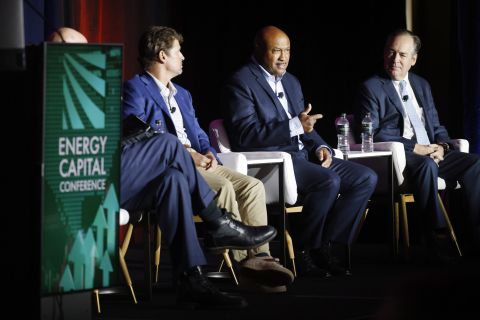
The GPA Sour Gas and Sulfur Symposium today applies proven solutions to the complex process of removing H2S, CO2, and other contaminants from the gas stream, handling the acid gas produced, and complying with state and federal regulations for the process.
B. Gene Goar, consultant with Goar Sulfur Services and Assistance, industry veteran in handling sulfur, is set to co-chair the symposium with Michael Sheilan, senior staff consultant with Amine Experts Inc., a division of Sulphur Experts Inc.

B. Gene Goar, consultant, Goar Sulfur Service & Assistance
Goar convinced the GPA staff in 2010 that the conference needed a sour gas symposium. That first symposium drew high interest at that meeting among members involved in sour gas treatment and handling processes and prompted the return engagement this year, Goar said.
“When we put it together originally, we tried to pick the top experts. These people probably are some of the top experts in the industry in the subjects they'll be talking about,” Goar said as he previewed the event.
Those experts include Sheilan, speaking on Sour Gas Treating; Johnny Johnson, with URS Energy & Construction, speaking about Claus Sulfur Recovery Units; Dennis Koscielnuk, with Jacobs Canada, talking about Tail Gas Clean-up Units; Elmo Nasato, with Goar Allison Ltd., explaining Sulfur Handling; and David Crowther, of Crowther & Associates, unraveling SRU/TGCU (sulfur recovery units/tail gas clean-up units) Environmental Permits, Regulations, and Guidelines.
Each will offer a half-hour presentation, leaving an hour and a half for questions and answers.
The presentations follow the path of gas through the treatment process, Goar said. Gas sweetening starts with sour gas treatment, the different techniques and processes to efficiently get the contaminants into solution, and the regeneration and re-cycling of the solvent.
The second paper includes sulfur removal from the acid gas produced with flow sheets and plant design for the Claus process, which removes 95% to 96% of the sulfur present in the gas stream.

Michael Sheilan, senior staff consultant, Amine Experts Inc.
The third paper discusses old and new processes for tail gas clean-up, which raises sulfur recovery to 99.5% or more.
The fourth paper offers guidelines for storing the recovered sulfur and preparing it for transportation, and the final paper deals with regulation of the SRU and TGCU processing and handling operations.
“It's the whole array from start to finish,” Goar said.
People attending the symposium also will receive an outline of the presentations, and the GPA will post slides of the talks on its website.
“Over the past 10 to 15 years, the (gas processing) industry has gotten younger,” Sheilan said. “People are young and eager but lack the mentorship of experienced people. We want them to understand the process, not just the equipment. Operators need to understand how the chemicals should be used and what the process capabilities are.”
The program will offer tips, guidelines, benefits, and pitfalls for treatment options. “It will tell them what to look for as engineers or managers to get the most from their equipment,” he added.
It will concentrate on the fundamentals; for example, why certain chemicals are used and why they react the way they do.
“This is a compendium of information which is difficult to find,” he said. “I hope it will tweak some discussion from the group. Discussion is the real benefit. Networking alone is important.”
The speakers at the symposium represent hundreds of years of experience and expertise in their fields and travel the world to apply that expertise to sour gas treatment planning and problem solving, Sheilan said.
Asked what he hoped people attending the symposium would take home with them, he said, “The whole process seems daunting, but with an understanding of the fundamentals of what the process is trying to do, they can develop the right tools. They can go back to their facilities and take some of the mystery away. It's not as scary as they might have thought it could be.”
Conferees can look at the processes and feel they can evaluate what they've got, prioritize protective measures, and make their processes safe and environmentally sound, Sheilan added.
Recommended Reading
Dividends Declared (Sept. 30 - Oct. 11, 2024)
2024-10-11 - Here is a compilation of dividends and distributions declared from select upstream, midstream and service and supply companies from Sept. 30 to Oct. 11.
Post Oak Backs New Permian Team, But PE Faces Uphill Fundraising Battle
2024-10-11 - As private equity begins the process of recycling inventory, likely to be divested from large-scale mergers, executives acknowledged that raising funds has become increasingly difficult.
Delek Logistics Partners Raises $166MM in Offering to Pay Debt
2024-10-11 - Delek Logisitics Partners closed an offering of 4.42 million common units to generate gross proceeds of $166 million.
Citgo Auction in Jeopardy as Venezuela Bondholders Pursue Parallel Claims
2024-10-11 - The court cases have increased uncertainty over which company is best positioned to take over the seventh-largest U.S. refiner Citgo Petroleum.
Comments
Add new comment
This conversation is moderated according to Hart Energy community rules. Please read the rules before joining the discussion. If you’re experiencing any technical problems, please contact our customer care team.



